Bees Overwintering
Preparation of Bee Colonies for Overwintering
To achieve high honey production, it is crucial to pay attention to how bee colonies are prepared for hibernation, how they are managed, and their condition at the time of hibernation.
Honey Removal
When the bee grazing season is over, and nectar intake stops, it is essential to remove the honeycombs (extensions and semi-extensions) and store them in a warehouse. The empty honeycombs should also be carefully stored.
The basic rule of beekeeping is to avoid touching excess honeycombs in the hive with the bee company, especially during the grazing and preparation period for overwintering. The bee colonies' nests should be narrowed down to the required extent according to their strength, and excess honeycombs should be removed.
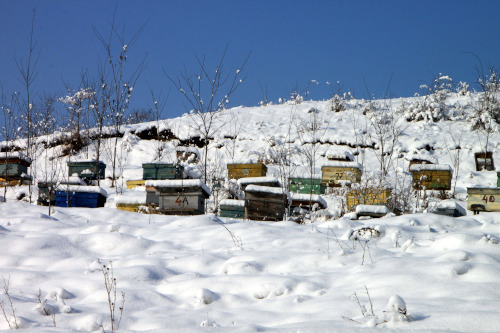
It is essential to store the honeycombs in rooms where they will be kept until the next season. If there is excess honeycomb in the hatching area, shake the bees out of it and remove it from the hive. The old and blackened honeycombs should be removed first, whose cells are expanded or all the honeycombs should be narrowed down. Such honeycomb is not suitable for making young bees, and it should be melted in wax.
Honeycomb is susceptible to wax moth attacks, so it should be kept in closed and dry rooms with wire nets with windows through which moth butterflies cannot enter, allowing ventilation at the same time.
Frames with empty honeycombs are arranged in semi-extensions or extensions, but less frequently than in the hive. The extensions and semi-extensions are then arranged on top of each other to the height that the room allows, but completely lying on top of each other to prevent any opening where butterfly moths could lay eggs on the honeycomb.
Detailed Overview of Bee Colonies
To ensure the proper preparation of bee colonies for overwintering, it is important to perform detailed examinations twice a year without disturbing the bees. The first examination should be conducted during wintering, and the second before the start of preparation for wintering. During the second inspection, several key elements must be evaluated, such as the strength of the bee colony, the quantity and quality of food in the hive, the existence and quality of the queen, the condition of the honeycombs, and the health of both worker bees and brood. These factors are crucial in making timely and proper preparations for the upcoming season.
Along with the detailed inspection, the beehive may also need rearrangement at a later time if necessary. In strong colonies where the end frames are filled with at least half honey, rearrangement is not required. Otherwise, the size of the nest should be evaluated, and excess space in the hive should be removed by wrapping a frame with empty honeycomb on each side with a layer of newsprint and placing it next to the nest. The paper should touch the base, and then a partition board should be placed.
The size of the nest can be estimated according to the number of occupied streets. The number of occupied streets can be best seen before the bee club is formed by opening the hive earlier in the morning when it's colder and taking a look through the gaps from the boards. The size of the nest can be estimated again when it warms up, as the bees then thin out. Based on the number of occupied streets, the amount of honey can be estimated, and this is a reliable basis for determining the size of the nest. When rearranging the nest, the extra frames are taken out and stored in the warehouse. The empty space in the hive is then filled with warming material, pads, quince, newsprint, etc.
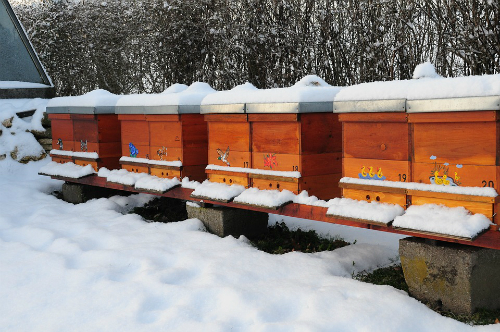
When rearranging the beehive, frames with more honey, especially those from the earlier bee hive, should be moved to the central part of the hive, and those that are partially filled with honey should be placed towards the ends of the hive. The same should be done with frames filled with pollen powder so that the food is closer to the bee club when it is formed. It is advisable to put 4 to 5 frames with honey and pollen powder in the central part of the hive at a normal distance from each other and the rest a little less often. One to two frames can be removed from the brood to achieve this.
It is common for some bee colonies to have a surplus of food while others do not have enough to overwinter, especially in certain years. In such cases, food should be exchanged between the hives. For colonies with a surplus, one or two frames with honey can be taken away and added to those in need, provided that all the colonies in the apiary are equally healthy. Honey from early grazing is preferred for overwintering as it is lighter in color than late grazing honey.
Winter Food for Bees
After inspecting bee colonies, the first task is to ensure they have enough food for overwintering, pre-spring, and early spring development. It is essential to estimate the amount of food required for each winter society to survive based on their strength. From my experience and other beekeepers' opinions, it takes about 2.7 to 3 kilograms of honey for each street inhabited by bees in Dadan-Blato's hive.
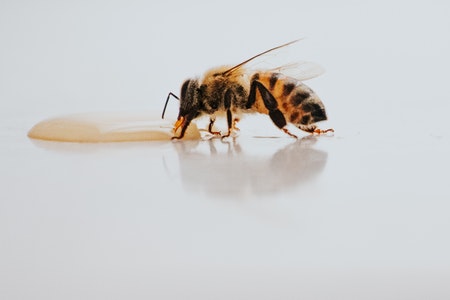
If there is not enough honey in the hive for wintering, feeding is necessary to make up the difference between the existing and required amount of honey. Typically, a bee colony needs 16 to 30 kilograms of honey for overwintering, pre-spring, and early spring development, depending on the colony's strength and the length of wintering, which varies by region. If sugar is fed to create a reserve food for wintering, it is best to do so before the young bees that will overwinter hatch. This is because if these young worker bees consume large amounts of sugar, it can reduce their vitality, which can negatively affect pre-spring and early spring activity to restore the bee colony.
If there is forest honey or honey from fruit juices in the hive, it should be completely squeezed out since it is not suitable for feeding bees over winter. These types of honey contain indigestible substances that can cause diarrhea and diseases of the digestive organs, leading to severe cases where the bee colony may die. Honey made from sugar syrup is ideal for overwintering bees since it does not contain indigestible substances. Sugar is crucial in beekeeping as a reproductive material, and without it, there can be no advanced beekeeping and high and profitable honey production. To provide honey for wintering, pour as much syrup into the feeder every night as the bees can consume and place in one night. This ensures the desired effects are achieved quickly.
Bees that live longer can produce young to replace them in early spring, have a much more developed fat body, are more vital, and can produce, use, and store heat in winter, which is vital for overwintering. They can work and perform their functions even under challenging conditions, such as successfully feeding and nurturing the brood. For bees to produce as many young workers as possible during this period, they must have at least enough nectar-producing plants to ensure their daily intake is at least 200 to 300 grams. If there is no such intake, then the society should be stimulated with honey or sugar syrup, sugar cakes, or sugar-honey dough starting from the beginning of August. If sugar syrup is used for stimulation, feed 150 to 200 grams of syrup into the feeder every night when the bees stop flying out of the hive, keeping in mind the aforementioned considerations. If sugar cakes or sugar-honey dough is used for stimulation, place them on the cover board from above, around the opening for ventilation and feeding, if the hive has a runaway and an opening for feeding and ventilation on the cover board.
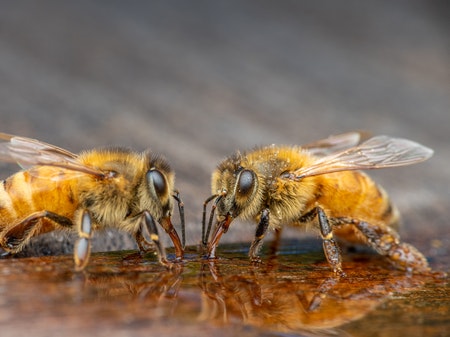
Feeding bee colonies dry food has the advantage that they do not need to be fed every night, but only every ten days with a kilogram to a kilogram of sugar cakes or sugar-honey dough. This method also reduces the risk of predation and workload for beekeepers, especially those whose beehives are located far from their place of residence. However, liquid food can achieve greater effects, as bees can consume more food in one evening, encouraging the queen to lay more eggs and thus promoting faster development of the bee colony with a larger number of worker bees being born.
In order for bee colonies to develop into strong production companies with high honey production, they need to enter the winter with around 35,000 young worker bees bred from August until taking.
Disadvantages That Can Disrupt and Damage Bee Colonies During Hibernation
- Strong earthquakes can cause bees to disengage from the hive in which they spend the winter, leading to bees falling off the hive and dying on the floor. The more bees that fall off the hive, the harder it is for the bees to overwinter. With strong earthquakes, the whole colony can die.
- The presence of varroa in the bee colony on a larger scale can have a detrimental effect on the overwintering of the bee colony.
- Stinging mice and other pests that enter the hive during the winter can cause great damage depending on the intensity of the attack.
- Frequent and significant changes in climate during the winter can also cause damage to bee colonies. For example, warm, sunny days followed by cold, windy days with snowfall can be harmful. When warm days appear in mid-January, the whole bee colony is activated, and food consumption, microclimate, and bee brood all change. When the colony later returns to its original state, the bees lose their vitality.
All these phenomena can disturb the normal wintering of bee colonies, causing worker bees to become tired and lose their vitality. Such workers are unable to provide the necessary warmth, care, and feeding for the brood after wintering, which can lead to lower honey yields. Therefore, special attention should be paid to the preparations for overwintering, wintering, and care of bee colonies.
When feeding bees to provide reserve food for overwintering, it is best to do so before young worker bees are taken out to overwinter, so that they do not process sugar into honey and reduce their vitality. This is particularly important when varroa is present in bee colonies on a larger scale.
How Bees Overwinter
To better understand how to care for bee colonies during the winter, here is a brief overview of their life in the hive during the cold season. When temperatures drop below 13 degrees Celsius, bees form balls to overwinter. These balls help the bees withstand the cold, as they are sensitive to low temperatures. The bees attach to each other in the ball and produce heat to keep themselves warm. They constantly move inside the ball to distribute heat production and maintain basic life functions until the weather improves. The ball has a slightly elongated shape with a cavity inside, and the bees do not rest but rather make quiet and light movements to produce, store and use heat efficiently.
Interestingly, there can be up to a 20-degree Celsius difference between the temperature inside the ball and outside of it, just 10 centimeters apart. The bees in the ball consume very little food during the winter, much less than during the grazing period. As a result, they can go a long time without cleaning, as long as they are provided with quality food. If they are given poor-quality food, such as forest honey or fruit juice honey with indigestible substances, bees can suffer from diarrhea, which can have harmful consequences and even cause colonies to die.
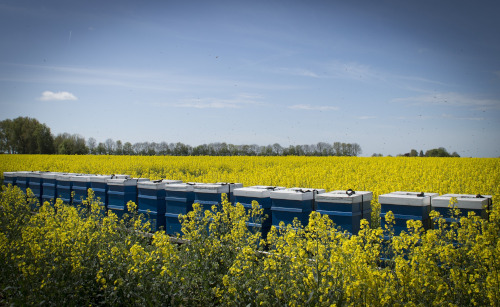
On warmer and sunnier days, bees fly out of the hive to clean themselves. However, during the great cold, bees cannot leave the ball to search for food. Instead, they look for food in the immediate vicinity of the ball, primarily above it where the honey cap or honey wreath is located. High humidity levels can also be problematic during winter, as it can cause water vapor to turn into droplets inside and outside of the hive. Proper ventilation is crucial to prevent excess moisture and potential damage to the hive.
Beekeepers must take measures to enable their colonies to overwinter successfully. It is important not to disturb the bees while they are in the ball, as even the smallest disturbance can cause them to fall off and die. Knowing the living conditions and life of bees in winter, beekeepers can ensure that their colonies stay healthy and strong throughout the cold season.
Improving the Overwintering of Bees
How well a colony develops in the spring and how much honey it produces during the main grazing period depends largely on how well it was prepared for winter and how well it was taken care of throughout the season. After removing the entire litter or reducing it to a minimum, it's important to treat the beehives against varroa following the instructions provided when purchasing protective equipment.
Before taking any further action, it's also important to determine whether the bee colonies should be kept warm or not. It's worth noting that bee colonies are more commonly affected by excess moisture or hunger rather than the cold. Therefore, it's important to keep the bees warm during winter while also providing them with sufficient quantities of quality food for wintering, pre-spring and early spring development, and regulating ventilation so that all water vapor exits the hive or is absorbed by the warming material. Failing to do so can result in water vapor condensing in the hive, which can cause significant damage to the honeycomb, honey, pollen powder, and the bee colony as a whole. In severe cases, bee colonies can die. Warming the bee colonies during winter should not come at the expense of proper or complete ventilation in the hive.
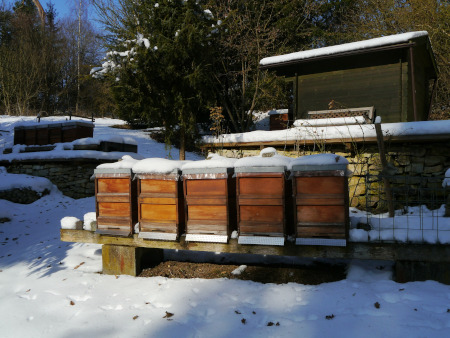
In order to improve ventilation, it's recommended to have an entrance reducer on the hive that provides enough openings for fresh air to enter even when a comb is placed against it to prevent the entry of pests. Additionally, an opening on the cover board for ventilation and feeding of bees creates an air column between the flight and the opening on the cover board, which facilitates the flow of fresh air through the hive, significantly improving the microclimate. To make ventilation even easier and more effective, the hives should be placed on a stand that is slightly inclined towards the flight, allowing all water that enters the hive to slowly flow out through the summer. If the hive is tilted back or is in a completely horizontal position, water that enters the hive during showers with strong wind can accumulate on the base and cause harmful consequences.
It is crucial to timely take bee colonies before they prepare themselves for winter. During autumn, the bees quickly prepare for winter by reducing or stopping egg-laying by the queen, sealing the hive cavities with propolis, and fastening frames. The cover board also sticks tightly to the hive body. Beekeepers should not wait for the bees to complete these tasks as opening the hive later will disrupt the bees' work, and they will have to spend energy and resources to redo it. Moreover, sudden cold weather can prevent the bees from doing it all over again, which can be detrimental during the winter. Therefore, it's necessary to take bees in a timely manner to prevent such risks.
Determining when to prepare colonies for overwintering is challenging, and it mostly depends on climatic conditions. Gradually taking bee colonies during the nest is ideal. All work inside the hive during the takeover should be completed, such as separating the empty space from the bee nest, often using a partition board. In colder areas, beekeepers use an empty frame or a frame with an empty honeycomb wrapped in newsprint to separate the empty space from the hive. Newsprint serves as an excellent insulator and absorbs excess moisture in the hive. Water vapor moves towards the cover board and exits through the opening towards it. Newsprint can retain moisture until the bee colonies' next spring.
After rearranging the bee nest, it's necessary to take the hive finally after some time, mostly in the continental part in the second half of October or the beginning of November. During this time, the hive is not opened, and the cover board is not removed, but only warming material is placed between the cover board and the escape.
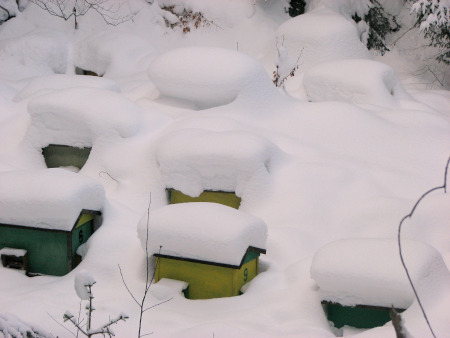
If bee colonies are strong and properly prepared, they will likely overwinter better and develop more in the spring when taken in two parts instead of one. However, certain conditions must be met for this to happen. About 75% of the capacity of the upper part of the hive should be filled with quality honey, preferably from earlier bee pastures, and there should be enough pollen powder. In the lower part of the hive (fruiting body), there should be about 7 kilograms of honey and a little more pollen powder than in the upper part. The rest of the space should be occupied by empty honeycombs from which the last litter was removed before final wintering.
When bee colonies are taken, the upper body of the hive should be full of food, the middle body should be filled with 50% of the total capacity, and the lower part may have less food. To ensure safe wintering, larger amounts of honey - 20 to 30 pounds - should be left. During the winter, due to warm air and more food in the upper part of the hive, the bees retreat upwards. By the end of winter, almost all worker bees and queens are in the upper part of the hive, where queens lay eggs in honeycomb cells that were recently consumed and cleaned. In early spring, the queen speeds up egg-laying, so the entire empty honeycomb in the upper part of the hive is filled with brood. The first replacement of the hive parts is then done carefully, with the upper part on the base and the lower part on top, leaving larger amounts of honey in the lower part of the hive. Since it is natural for bees to store honey in the upper part of the hive, they will transfer honey from the lower to the upper part, giving the impression of a richer bee pasture. The brood intensively feed the queen, and she lays an increasing number of eggs every day, leading to the rapid development of the colony.
After some time, the queen and most of the colony will move to the upper part of the hive, which is warmer, and continue to develop the brood there. This is one of the essential measures for the rapid development of bee colonies, which cannot be achieved if they are taken in one part of the hive.
Caring for Bee Colonies During Winter
To ensure that bee colonies survive the winter, it's essential to prepare the apiary in the fall. The first step is to repair any damages to the fence to protect the bees from wild and domestic animals. Clear the area around the apiary and remove any grass or debris that could serve as a shelter for pests. Ensure that the hives are well-maintained with quality food, a healthy queen, and enough worker bees to survive the winter. If these conditions are met, the bees can successfully winter outside, in the same location where they were grazing.
It's crucial to maintain absolute peace in the apiary and protect the hives from strong winds and snow. Any disturbance to the hives during cold weather can be harmful to the bee colonies. Bees can fall off the ball and die on the bottom board if shaken during an earthquake or any other disturbance. To prevent this, it's necessary to fence off the beehives and keep them away from animals that can cause damage. Avoid locating hives next to fences or trees that could fall on them, especially during winter pruning.
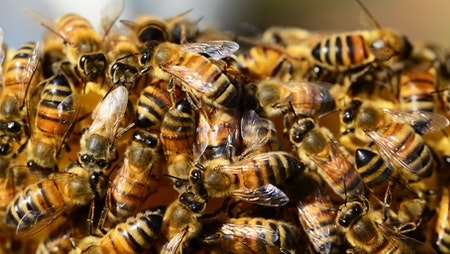
In winter, heavy snowfalls and melting can cause the flight path to close, leading to suffocation of the bee colony. Therefore, it's essential to inspect the hives periodically and clear any snow, ice, or dead bees. However, great care must be taken not to shake or move the hive, so the bees don't fall from the ball and die on the bottom board. The snow on the roof of the hive should not be removed as it serves as an excellent heat insulator, but only if it is necessary to expand capacity. Other necessary tasks include putting hives, nuclei, and substrates in reserve, constructing and wiring frames, procuring necessary accessories and reproduction material such as sugar.
In winter, it's also crucial to study beekeeping literature more intensively, including books, magazines, and attending seminars, conferences, and exhibitions related to beekeeping. Recording useful information in a special notebook can help in more successful beekeeping the following year. Attending such events can be beneficial as they provide an opportunity to learn and apply new skills in beekeeping. Investing time and money in beekeeping events can be beneficial in the long run.
arrow_upward